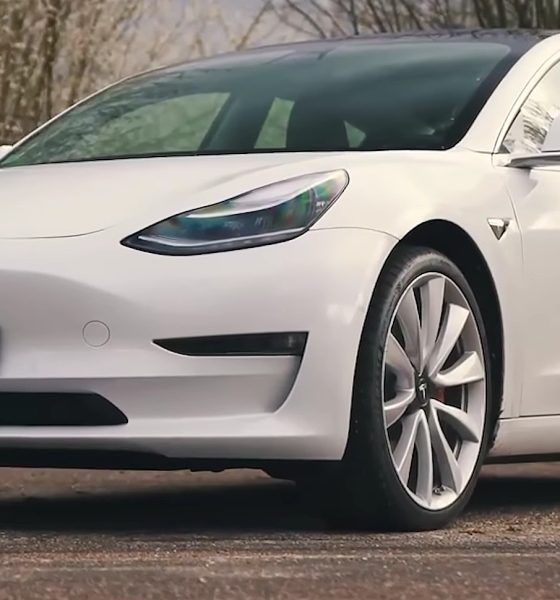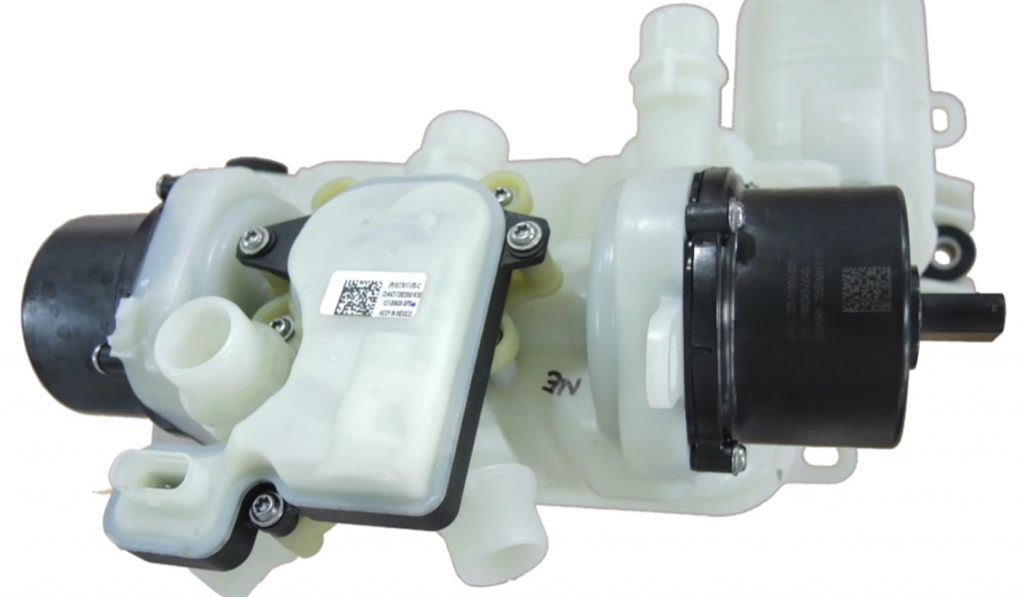

News
Tesla ‘Superbottle’ proves that the Model 3’s disruption lies in its vertical integration
During a recent interview with Tesla owner-enthusiast Sean Mitchell, Detroit veteran Sandy Munro of Munro and Associates mentioned that among the Model 3’s unique components, its “Superbottle” is one of the most innovative. Combining two pumps, one heat exchanger, and one coolant valve in one cleverly-designed bottle, the Model 3’s cooling system is arguably the most unique in the auto industry.
The traditional automotive industry is all about suppliers and outsourcing the different components of a vehicle to different companies. This results in cars having redundant components. The Chevy Bolt, for example, has three cooling systems: one for its battery pack, one for its cabin, and one for its electronics. This is not the case with the Model 3, as the fondly-named Superbottle handles the entire cooling system of the whole vehicle — battery pack, cabin, and electronics included.
The Superbottle has garnered much recognition even among noted gearheads such as Jalopnik‘s David Tracy, who used to design automotive cooling systems himself. Munro, for his part, noted that the Superbottle actually gives several advantages for Tesla, such as increased modularity and packaging space, potential weight savings, reduced final assembly costs, and reduced final assembly time, to name a few. For Munro, the novel cooling system is the very definition of Tesla’s vertical integration.

“The Superbottle is a great example of how the normal automotive companies don’t work together, and Tesla does. That Superbottle crosses many lines that you can’t cross here (in Detroit). If I’m in charge of engine cooling or battery cooling, I don’t want nothing to do with cooling the cabin. And yet, we’ve got the motor cooling, the battery cooling, and electronics, all going through one little bottle that’s got some clever little ball valves that open and close to make sure that everything’s getting heated or everything’s being cooled to where it needs to be. We all thought that was the best thing in the whole damn car,” Munro fondly commented.
Discussing the Superbottle further, Munro mentioned how the cooling system is fitted with a bottle avatar dressed as a superhero. According to the auto veteran, this funny little character is a notable representation of just how different Tesla is as a car maker, as such fun Easter Eggs in a vehicle will never be allowed in traditional automakers. Together with the vertical integration that is showcased in the Superbottle, Tesla’s apparent support for creativity among its engineers and designers is something that is simply not present in traditional automakers today.
In a recent video, Tesla investor-enthusiast Galileo Russell of HyperChange TV noted that innovations such as the Superbottle could open the doors for the electric car maker’s other products. It is most certain that the Superbottle will end up in the Model Y, and variations of it would likely be used in other vehicles such as the Pickup Truck, the Semi, and the next-gen Roadster. Perhaps, Russell mused, Tesla’s Superbottle solution could even be utilized on the company’s upcoming HVAC products, which Elon Musk hinted at during his extensive podcast with Joe Rogan last year.
Tesla catches a lot of flak due to the fact that the company and its CEO, Elon Musk, seems unwaveringly intent on reinventing the wheel. With each new vehicle that it introduces, Tesla steps farther and farther away from traditional automakers. This is represented by the fact that the company is currently developing a literal giant casting machine for its Model Y crossover, which is expected to reduce the number of parts for the vehicle. And this is just the tip of the iceberg, as Tesla is also developing its custom Silicon for its full self-driving projects. It is then no surprise that when Sandy Munro was discussing how traditional automakers are playing catchup to Tesla in the EV market, he noted that “really and truly, all the domestics (automakers such as Ford and GM) are way behind.”

Elon Musk
Elon Musk and Tesla AI Director share insights after empty driver seat Robotaxi rides
The executives’ unoccupied tests hint at the rapid progress of Tesla’s unsupervised Robotaxi efforts.

Tesla CEO Elon Musk and AI Director Ashok Elluswamy celebrated Christmas Eve by sharing personal experiences with Robotaxi vehicles that had no safety monitor or occupant in the driver’s seat. Musk described the system’s “perfect driving” around Austin, while Elluswamy posted video from the back seat, calling it “an amazing experience.”
The executives’ unoccupied tests hint at the rapid progress of Tesla’s unsupervised Robotaxi efforts.
Elon and Ashok’s firsthand Robotaxi insights
Prior to Musk and the Tesla AI Director’s posts, sightings of unmanned Teslas navigating public roads were widely shared on social media. One such vehicle was spotted in Austin, Texas, which Elon Musk acknowleged by stating that “Testing is underway with no occupants in the car.”
Based on his Christmas Eve post, Musk seemed to have tested an unmanned Tesla himself. “A Tesla with no safety monitor in the car and me sitting in the passenger seat took me all around Austin on Sunday with perfect driving,” Musk wrote in his post.
Elluswamy responded with a 2-minute video showing himself in the rear of an unmanned Tesla. The video featured the vehicle’s empty front seats, as well as its smooth handling through real-world traffic. He captioned his video with the words, “It’s an amazing experience!”
Towards Unsupervised operations
During an xAI Hackathon earlier this month, Elon Musk mentioned that Tesla owed be removing Safety Monitors from its Robotaxis in Austin in just three weeks. “Unsupervised is pretty much solved at this point. So there will be Tesla Robotaxis operating in Austin with no one in them. Not even anyone in the passenger seat in about three weeks,” he said. Musk echoed similar estimates at the 2025 Annual Shareholder Meeting and the Q3 2025 earnings call.
Considering the insights that were posted Musk and Elluswamy, it does appear that Tesla is working hard towards operating its Robotaxis with no safety monitors. This is quite impressive considering that the service was launched just earlier this year.
Elon Musk
Starlink passes 9 million active customers just weeks after hitting 8 million
The milestone highlights the accelerating growth of Starlink, which has now been adding over 20,000 new users per day.

SpaceX’s Starlink satellite internet service has continued its rapid global expansion, surpassing 9 million active customers just weeks after crossing the 8 million mark.
The milestone highlights the accelerating growth of Starlink, which has now been adding over 20,000 new users per day.
9 million customers
In a post on X, SpaceX stated that Starlink now serves over 9 million active users across 155 countries, territories, and markets. The company reached 8 million customers in early November, meaning it added roughly 1 million subscribers in under seven weeks, or about 21,275 new users on average per day.
“Starlink is connecting more than 9M active customers with high-speed internet across 155 countries, territories, and many other markets,” Starlink wrote in a post on its official X account. SpaceX President Gwynne Shotwell also celebrated the milestone on X. “A huge thank you to all of our customers and congrats to the Starlink team for such an incredible product,” she wrote.
That growth rate reflects both rising demand for broadband in underserved regions and Starlink’s expanding satellite constellation, which now includes more than 9,000 low-Earth-orbit satellites designed to deliver high-speed, low-latency internet worldwide.
Starlink’s momentum
Starlink’s momentum has been building up. SpaceX reported 4.6 million Starlink customers in December 2024, followed by 7 million by August 2025, and 8 million customers in November. Independent data also suggests Starlink usage is rising sharply, with Cloudflare reporting that global web traffic from Starlink users more than doubled in 2025, as noted in an Insider report.
Starlink’s momentum is increasingly tied to SpaceX’s broader financial outlook. Elon Musk has said the satellite network is “by far” the company’s largest revenue driver, and reports suggest SpaceX may be positioning itself for an initial public offering as soon as next year, with valuations estimated as high as $1.5 trillion. Musk has also suggested in the past that Starlink could have its own IPO in the future.
News
NVIDIA Director of Robotics: Tesla FSD v14 is the first AI to pass the “Physical Turing Test”
After testing FSD v14, Fan stated that his experience with FSD felt magical at first, but it soon started to feel like a routine.

NVIDIA Director of Robotics Jim Fan has praised Tesla’s Full Self-Driving (Supervised) v14 as the first AI to pass what he described as a “Physical Turing Test.”
After testing FSD v14, Fan stated that his experience with FSD felt magical at first, but it soon started to feel like a routine. And just like smartphones today, removing it now would “actively hurt.”
Jim Fan’s hands-on FSD v14 impressions
Fan, a leading researcher in embodied AI who is currently solving Physical AI at NVIDIA and spearheading the company’s Project GR00T initiative, noted that he actually was late to the Tesla game. He was, however, one of the first to try out FSD v14.
“I was very late to own a Tesla but among the earliest to try out FSD v14. It’s perhaps the first time I experience an AI that passes the Physical Turing Test: after a long day at work, you press a button, lay back, and couldn’t tell if a neural net or a human drove you home,” Fan wrote in a post on X.
Fan added: “Despite knowing exactly how robot learning works, I still find it magical watching the steering wheel turn by itself. First it feels surreal, next it becomes routine. Then, like the smartphone, taking it away actively hurts. This is how humanity gets rewired and glued to god-like technologies.”
The Physical Turing Test
The original Turing Test was conceived by Alan Turing in 1950, and it was aimed at determining if a machine could exhibit behavior that is equivalent to or indistinguishable from a human. By focusing on text-based conversations, the original Turing Test set a high bar for natural language processing and machine learning.
This test has been passed by today’s large language models. However, the capability to converse in a humanlike manner is a completely different challenge from performing real-world problem-solving or physical interactions. Thus, Fan introduced the Physical Turing Test, which challenges AI systems to demonstrate intelligence through physical actions.
Based on Fan’s comments, Tesla has demonstrated these intelligent physical actions with FSD v14. Elon Musk agreed with the NVIDIA executive, stating in a post on X that with FSD v14, “you can sense the sentience maturing.” Musk also praised Tesla AI, calling it the best “real-world AI” today.








